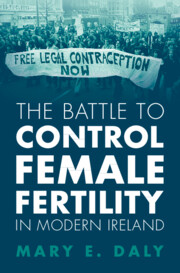314 results
3 - Sexuality in the Systems of Thought and Belief of the Ancient Near East
-
-
- Book:
- The Cambridge World History of Sexualities
- Published online:
- 26 April 2024
- Print publication:
- 16 May 2024, pp 43-62
-
- Chapter
- Export citation
12 - Sexuality in Jewish Traditions
-
-
- Book:
- The Cambridge World History of Sexualities
- Published online:
- 26 April 2024
- Print publication:
- 16 May 2024, pp 250-270
-
- Chapter
- Export citation
The impact of female education on fertility: evidence from Malawi Universal Primary Education program
-
- Journal:
- Journal of Demographic Economics , First View
- Published online by Cambridge University Press:
- 18 March 2024, pp. 1-29
-
- Article
- Export citation
13 - Demography
-
-
- Book:
- Human Behavioral Ecology
- Published online:
- 07 March 2024
- Print publication:
- 14 March 2024, pp 307-332
-
- Chapter
- Export citation
Family History of Twinning and Fertility Traits in Nigerian Mothers of Dizygotic Twins
-
- Journal:
- Twin Research and Human Genetics / Volume 27 / Issue 1 / February 2024
- Published online by Cambridge University Press:
- 31 January 2024, pp. 12-17
-
- Article
-
- You have access
- Open access
- HTML
- Export citation
6 - The Toll of Treatment
- from Part Two - The Science behind Cervical Cancer
-
- Book:
- Enough
- Published online:
- 11 January 2024
- Print publication:
- 11 January 2024, pp 66-79
-
- Chapter
- Export citation
Grandmother effects over the Finnish demographic transition
-
- Journal:
- Evolutionary Human Sciences / Volume 6 / 2024
- Published online by Cambridge University Press:
- 04 January 2024, e6
-
- Article
-
- You have access
- Open access
- HTML
- Export citation
Calcium and vitamin D homoeostasis in male fertility
-
- Journal:
- Proceedings of the Nutrition Society / Volume 83 / Issue 2 / May 2024
- Published online by Cambridge University Press:
- 11 December 2023, pp. 95-108
-
- Article
-
- You have access
- Open access
- HTML
- Export citation
GWAS of Dizygotic Twinning in an Enlarged Australian Sample of Mothers of DZ Twins
-
- Journal:
- Twin Research and Human Genetics / Volume 26 / Issue 6 / December 2023
- Published online by Cambridge University Press:
- 23 November 2023, pp. 327-338
-
- Article
-
- You have access
- Open access
- HTML
- Export citation
Chapter 20 - The Modern Semen Analysis
- from Section 4 - Laboratory Evaluation and Treatment of Male Infertility
-
-
- Book:
- Men's Reproductive and Sexual Health Throughout the Lifespan
- Published online:
- 06 December 2023
- Print publication:
- 16 November 2023, pp 159-164
-
- Chapter
- Export citation
Chapter 11 - The Effects of Aging on Male Fertility and the Health of Offspring
- from Section 2 - The Biology of Male Reproduction and Infertility
-
-
- Book:
- Men's Reproductive and Sexual Health Throughout the Lifespan
- Published online:
- 06 December 2023
- Print publication:
- 16 November 2023, pp 87-96
-
- Chapter
- Export citation
Fertility and ageing – actuarial perspectives
-
- Journal:
- British Actuarial Journal / Volume 28 / 2023
- Published online by Cambridge University Press:
- 21 September 2023, e6
-
- Article
-
- You have access
- Open access
- HTML
- Export citation
Deconconstructing Colonial Population Anxiety - Population Politics in the Tropics: Demography, Health and Transimperialism in Colonial Angola By Samuël Coghe. Cambridge: Cambridge University Press, 2022. Pp. 317. $99.99, hardcover (ISBN: 9781108837866); e-book (ISBN: 9781108943307).
-
- Journal:
- The Journal of African History / Volume 64 / Issue 2 / July 2023
- Published online by Cambridge University Press:
- 23 August 2023, pp. 314-316
- Print publication:
- July 2023
-
- Article
- Export citation
7 - ‘Bona Fide Family Planning’
-
- Book:
- The Battle to Control Female Fertility in Modern Ireland
- Published online:
- 11 May 2023
- Print publication:
- 25 May 2023, pp 248-301
-
- Chapter
- Export citation

The Battle to Control Female Fertility in Modern Ireland
-
- Published online:
- 11 May 2023
- Print publication:
- 25 May 2023
Effect of core cultivation, fertility, and plant growth regulators on recovery of voided creeping bentgrass greens canopies following annual bluegrass control via methiozolin
-
- Journal:
- Weed Technology / Volume 37 / Issue 2 / April 2023
- Published online by Cambridge University Press:
- 13 April 2023, pp. 185-191
-
- Article
-
- You have access
- Open access
- HTML
- Export citation



